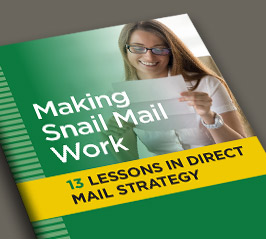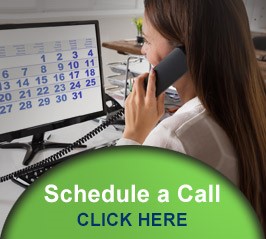
Direct Marketing / Direct Mail Services
There’s Direct Mail … and then there’s Digital Direct Mail
Direct mail still stands apart for its ability to target, connect and persuade, and now with digital, we can engage and automate.
We’ve been doing direct mail for more than 30 years. Depending on your needs, we provide a full-service direct mail campaign that includes list research, offer planning, format selection, testing strategy, creative and print/mail production.
And now we can take those direct mail campaigns to the next level.
Choose from two Digital enhancements
Basic Digital Enhancements
This is a fairly routine digital enhancement that we recommend for all direct mail clients:
- Landing page – provides a simple form of lead capture
- Thank You page – provides a follow-up page for a download or the next step in your sales process
- QR code – provides a fast and simple connection from your mailer to the landing page
- Call tracking services – provides a process for tracking the source of your phone calls
Advanced Digital Enhancements
This is where we expand your reach and reinforce your message through web advertising and social media (Facebook and Instagram) advertising.
We include everything from our Basic package plus the following:
- Facebook Ads before and/or after your mailing – served up directly to those on your list who can be identified as Facebook users
- Banner Ads across the web before and/or after mailing – served to the general marketplace where your prospects live and work
- Retargeting Ads on Facebook and/or Google – served to visitors of your website
Now, back to your Direct Mail campaign – and a series of questions
We prepared this direct mail overview using a series of questions and answers that we believe you should be asking as you think about and plan your upcoming campaign.
What type of campaign do you need?
Targeted Direct Mail – For both B2B and B2C applications, these are mailings targeted to a specific audience profile that we can match to a third-party mailing list. We can also use your own list. For B2B, this could mean SIC, company size and job title. For B2C, this could mean age, income, home value and more.
Saturation Direct Mail – For B2C marketers who want to reach every household or every homeowner in a particular zip code, Saturation Mail provides the best pricing available. I
Multi-Touch Direct Mail – If you have a targeted list of qualified prospects, you might to reach them more than once. A multi-touch campaign can be set up once and scheduled out over an extended time period. You can send them the same mailer over and over again. Or can create a series of mailers and send them in rotation.
Weekly/Monthly Direct Mail -This could be structured as a multi-touch mailing (reaching the same people multiple times) or it could be simply stretching out your mailing schedule to better manage your responses and your payments. We can create and print a large quantity, and then mail on a pre-arranged weekly or month schedule.
What’s your objective?
When you send out any direct mail, you need to have a reason, an objective. What you trying to accomplish with your campaign?
Are you hoping to generate leads, appointments, direct purchases, store traffic, website traffic, trade show traffic, subscriptions, memberships, donations?
Be clear about your objective because it will dictate some of your later decisions.
Who are you trying to reach?
This is about your mailing list, but before you go looking for lists, decide who you want to reach. Be as specific as you can. Describe your audience first by the demographics (age, gender, income, assets, home value, pets, etc.
If possible, try to identify what behaviors best describe your customers. What actions have they taken in the past to indicate an interest in your product or service. Do they belong to an organization, subscribe to a publication or participate in some activity that would match well with your audience?
Keep in mind too that your best list is always going to be your House List – made up customers and prospects, people who have had some engagement with you. This list or lists will likely generate the highest response.
But of course, the House List will only take you so far and you will need to use a cold list, a third-party list based on the demographics and behaviors mentioned above.
What mailer format do you want to use?
There are many different mailer formats – postcards, letter mail, self-mailers, large format mailers, snap-packs and more. But picking the right format shouldn’t be an aesthetic exercise. It should be based on your strategy, your audience, your offer and your budget.
Clearly, postcards are popular because they are simple, straightforward, often eye-catching and relatively inexpensive. Letter mail is better suited to personalization and a more serious communication. But sometimes, longer form direct mail is recommended.
Here’s a list of some common direct mail formats
- Postcards – multiple sizes
- Letter Mailers
- Letter/Brochure Mailers
- Folded Self-Mailers
- Large Format Mailers
- Snap Packs
- Specialized Postcards
- Shaped Postcards
- Magnet Postcards
- Plastic Postcards
- Scratch-Off Postcards
What action do you want people to take?
At the end of the day, your mailing will be judged by how many responses you get. So, what do you want those responses to look like? What call to action would you like to use to generate a response?
Most of us would like responses in the form of a purchase, but that doesn’t happen very often. Almost never except in special cases. Next down would be a response in the form of an appointment request, or a quote request or a consultation request. This certainly possible, but your response rate is likely to be very small – in the lower fractions fo 1%. The quality of those leads will be good, the volume will be small.
To generate more responses (albeit lower quality), you want to offer something of value (a free guide, for example) that can be downloaded with minimal engagement or commitment.
As you can see, your call to action is part of sliding scale with high-commitment CTAs (low response but high quality) on one end and low-commitment CTAs (high response but low quality) on the other. Finding the right CTA should be a high priority goal for you.
How will you help them respond?
When people are ready to respond, you want to make it as easy as possible to take action. This means offering multiple response channels – phone, landing page and reply mail.
Phone is an obvious choice, but you might also consider an 800 number or a 24/7 answering service. Landing pages are common these days and most people are able to navigate them fairly easily. Reply mail used to be more common and is still recommended, but not everyone wants to pay for extra printing and the business reply permit costs.
What will happen after they respond?
This is an often-overlooked step in the process. It used to be that once you generated a lead, you would send that lead over to sales and they would take it from there. But not anymore.
Today, we have the ability to stay in touch by automated email so even if your sales person drops the ball and doesn’t follow up, you can be sure your message is still getting delivered.
We strongly recommend you have a lead nurturing email sequence in place before you start to generate leads from direct mail.
What kind of response rate can you expect?
As you can imagine, it varies. If you are mailing to a cold list (people who have no history with you), you are probably looking at a response rate of 1% – maybe up to 2%, but more likely in the fractions of 1%.
Your response rate is likely to be determined by the call to action you use in your mailer.
If your call to action is a free download (like a guide, whitepaper, checklist or some other lead magnet), you can expect something close to 1% or higher.
If your call to action is to schedule an appointment, request a quote or request a free consultation, you should expect a response rate no higher than 1/2 of 1% – and probably lower.
If you are mailing to a House List of past customers or qualified prospects, all of the above scenarios should produce a much higher response – in fact, several times higher.
What services do you provide?
We offer two direct mail programs that only differ by the front-end services we provide.
Ready2Run Direct Mail is for those customers who know what they want and just need help with execution. You give us your message and a profile of your audience. We’ll design the mailer and get it printed, addressed and mailed – for one set price.
Custom Direct Mail is for customers who may need or prefer more guidance with their direct mail strategy, list research, offer strategy, format selection and testing strategy as well as creative direction and copywriting. This is particularly well suited for those who want to improve an existing campaign.
Both programs provide complete direct mail production – mailing list, printing, addressing/mailing and postage – plus a landing page and online advertising support.
How many pieces should you mail?
You can mail any quantity you want – from a few hundred pieces up to many tens of thousands.
But keep in mind, the smaller your quantity, the higher your per-piece cost.
To keep your cost per piece under $1, we would generally recommend at least 3,000 pieces.
One option is to print a larger quantity (say, 5,000 or 10,000) in advance, but only mail in smaller quantities as needed. This gives you the bulk volume savings on printing, but still have the flexibility of a smaller mailing.
Schedule an introductory call
We’d love to talk to you and find out what plans you have for using direct mail. Please click here to schedule an introductory phone call or Zoom meeting.
If you’d like to discuss an upcoming campaign – or if you’re looking for ways to improve an existing mailing program – call us and let’s schedule an introductory call.


